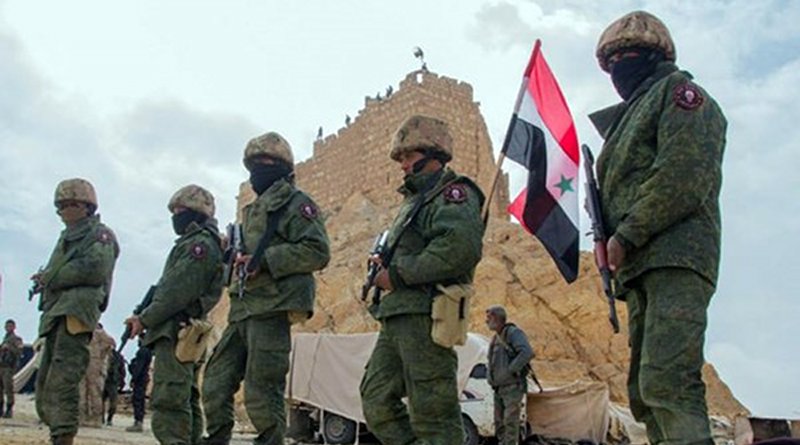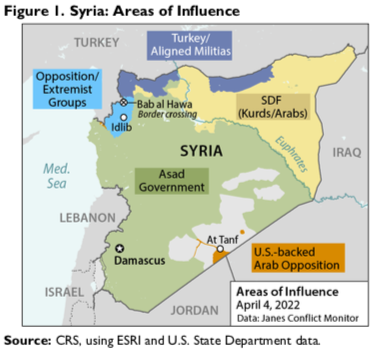Syria And US Policy – Analysis
By CRS
By Carla E. Humud*
Since 2011, conflict between the government of Syrian President Bashar al Asad and opposition forces seeking his removal has displaced roughly half of the country’s population and killed over half a million people. Five countries operate in or maintain military forces in Syria: Russia, Turkey, Iran, Israel, and the United States. The United States seeks a negotiated political settlement to the Syria conflict and the enduring defeat of the Islamic State (IS, aka ISIS/ISIL). Challenges for U.S. policymakers include responding to threats posed by IS remnants and detainees, countering groups linked to Al Qaeda, facilitating humanitarian access, and managing Russian and Iranian challenges to U.S. operations in Syria.
Syria in 2022: Protracted Stalemate
In early 2022, U.N. Special Envoy for Syria Geir Pederson described the conflict in Syria—between the Syrian government and its partners on one side and various opposition and extremist groups on the other side—as a “stalemate,” noting that “militarily, front lines remain unshifted.” Pederson also warned that “any of a number of flashpoints could ignite a broader conflagration.” Several rival administrations hold territory in Syria, including the following.
The Asad Government
The Asad government—backed by Russia, Iran, and aligned militia forces—controls about two thirds of Syria’s territory, including most major cities. In 2021, President Asad won a fourth seven-year term; U.S. officials described the election as “an insult to democracy.” Pockets of armed resistance to Asad rule remain, particularly in the south.
Kurdish-Arab Military and Civilian Authorities
Following the defeat of the Islamic State by the U.S.- backed Syrian Democratic Forces (SDF), Kurdish authorities and their Arab partners in northeast Syria established the Autonomous Administration of North and East Syria (AANES), also known as the Self Administration of Northeast Syria (SANES)—shown in yellow in Figure 1. The SDF and its political wing (the Syrian Democratic Council, SDC) play a leading role in the AANES, whose leaders have stated that it is not aligned with either the Asad government or with opposition forces.
Opposition and Extremist Forces
Opposition-held areas of northwest Syria are administered by the Syrian Salvation Government (SSG). The SSG was established in 2017 and is affiliated with Hayat Tahrir al Sham, which the United States has designated as a Foreign Terrorist Organization (FTO) due to its links to Al Qaeda. Many residents of this area have been displaced from areas of Syria now under Asad control, and an estimated 75% depend on U.N. assistance to meet their basic needs. Armed extremist groups also operate in this region.
Turkish Forces and Aligned Militias
Turkish-held areas of northern Syria include territories occupied in three military operations by Turkish forces in cooperation with Syrian Arab proxy forces (Operations Peace Spring, Euphrates Shield, and Olive Branch). In these areas, Turkey has established local councils subordinate to the Turkish provinces they border, with Turkish provincial governments overseeing the provision of some basic services. Many of the original inhabitants of Turkish-held areas remain in camps for internally displaced persons (IDPs) in AANES-held areas.
The Islamic State
U.S. military officials assess that the Islamic State remains entrenched as a cohesive, low-level insurgency, focusing its activities against Asad government forces in southwest Syria and the central Syrian desert, and against the SDF in northern and eastern Syria. In 2021, U.S. Central Command (CENTCOM) assessed that, “ISIS likely has sufficient manpower and resources to operate indefinitely at its present level in the Syrian desert.” In February 2022, a U.S. military operation in Idlib resulted in the death of IS leader Abu Ibrahim al Qurashi, also known as Hajji Abdullah. In March the group named a new leader. Some reports have identified him as Juma Awad al Badri, an Iraqi national and brother of former IS leader Abu Bakr al Baghdadi.
Islamic State Detainees. The SDF continues to hold about 10,000 IS fighters in detention facilities across northern Syria. In January 2022, U.S. air and ground forces in Syria joined SDF partner forces in a lengthy battle to retake a prison seized by IS fighters. It was the largest U.S. military engagement with the group since 2019. The SDF also retains custody of about 57,000 people linked to the Islamic State (mostly women and children) at the Al Hol IDP camp.
U.S. Policy
In late 2021, the Biden Administration completed a policy review on Syria and identified four policy priorities to meet the U.S. objective for a political settlement to the conflict as envisioned in U.N. Security Council Resolution 2254: (1) sustaining the U.S. and coalition campaign against the Islamic State; (2) supporting local ceasefires; (3) expanding humanitarian access; and (4) pressing for accountability and respect for international law while promoting human rights and nonproliferation, including through the imposition of targeted sanctions. The Biden Administration has stated that it will not recognize the Asad government, and that it opposes others doing so.
U.S. Military Presence: Operation Inherent Resolve
U.S. forces have operated inside Syria since 2015 pursuant to the 2001 and 2002 Authorizations for Use of Military Force (AUMF), amid ongoing debate in Congress about the authorization for U.S. operations in Syria. U.S. operations focus on countering the Islamic State as part of Operation Inherent Resolve (OIR). Roughly 900 U.S. troops are based in Syria to support counter-IS operations by local partner forces. Most U.S. forces are deployed in what military officials term the Eastern Syria Security Area (ESSA), in support of the SDF. About 100 U.S. personnel support Jaysh Mughawir ath Thawra (MaT), an Arab force, at the At Tanf garrison. At Tanf is located along a primary transit route between Iraq and Syria, including for IS fighters.
Since 2015, CENTCOM has conducted periodic military strikes in Syria outside the framework of OIR, including on targets linked to Al Qaeda, the Syrian government, and Iran-backed militias. In February and June 2021, the U.S. military conducted airstrikes against Iran-backed militias in eastern Syria, which have used Syria-based facilities to target U.S. forces in Iraq. Iran-backed militias also have targeted U.S. forces at At Tanf with armed drones.
U.S. Policy Tools
Syria Train and Equip Program
The United States continues to train, advise, and enable partner forces in Syria as part of the Syria Train and Equip program authorized by Congress in 2014. The program seeks to make partner forces in Syria capable of defeating the Islamic State. U.S. military officials in late 2021 stated that while SDF operations limited the Islamic State’s ability to reconstitute and conduct high-profile attacks, the SDF “remained fully dependent on the Coalition’s intelligence, surveillance, and reconnaissance capabilities.”
FY2022 Funding and the FY2023 Request. The Administration’s FY2022 defense funding request sought $522 million in Counter-ISIS Train and Equip Fund (CTEF) funding for train and equip programs in Iraq ($345 million) and Syria ($177 million). The FY2022 Consolidated Appropriations Act (Division C of P.L. 117- 103) makes $500 million available for CTEF, including $155 million for Syria. It also directs the rescission of $250 million in prior year CTEF funds. The FY2022 NDAA extends the authority for the program until December 2022. The Administration’s FY2023 defense funding request seeks $541 in CTEF funds, including $183 million for Syria.
Sanctions
The United States maintains sanctions on Syria relating to its support for terrorism, interference in Lebanon, use of chemical weapons, and human rights violations. The Biden Administration has expressed support for a regional deal to export natural gas and electricity from Egypt and Jordan to Lebanon via Syria, describing it as a humanitarian effort that would be funded by the World Bank and thus not require a sanctions waiver. In a February 2022 letter to Secretary of State Blinken, the ranking Members of the Senate Foreign Relations Committee and the House Foreign Affairs Committee argued that the deal would “undoubtedly enrich the Assad regime and trigger U.S. sanctions under the Caesar Syria Civilian Protection Act.”
Humanitarian Assistance
The United States is the largest donor of humanitarian assistance to the Syria crisis, allocating more than $14 billion since FY2012 for humanitarian efforts in Syria and in neighboring states that host Syrian refugees.
Cross-Border Assistance. Due to the Asad government’s obstruction of humanitarian assistance to opposition-held areas, the U.N. Security Council (UNSC) in 2014 authorized U.N. agencies to deliver humanitarian assistance cross-border via four international crossing points with notification to the Asad government. In 2020, the UNSC authorization was reduced to a single crossing point from Turkey (Bab al Hawa) due to pressure from Russia and China, who argued that cross-border aid violated Syrian sovereignty and that aid distribution should be coordinated with Syrian authorities from government-held to rebel-held areas (termed “cross-line” assistance). Humanitarian actors state that cross-line assistance cannot replace the scale of U.N. cross-border assistance. The current UNSC authorization for cross border aid expires in July 2022. Stabilization Assistance
The United States has provided more than $1.3 billion in stabilization assistance for Syria since 2011. The State Department describes such assistance as “a critical element in the OIR mission because it mitigates the economic and social cleavages previously exploited by ISIS, closes gaps in local authority capacity, and supports civil society to advocate for citizen needs.” The Department also has described stabilization assistance as a counterweight to the influence of Iran, Russia, and the Syrian government. Stabilization aid funds projects in non-regime-held areas.
Issues for Congress
Recent appropriations measures reflect congressional efforts to prioritize security at detention facilities for IS fighters, particularly following the January 2022 IS takeover of a detention facility in northern Syria. The FY2022 Consolidated Appropriations Act, presented to the President in March 2022, prohibits the use of CTEF funds in Syria and Iraq for any construction activity other than detention facility fortification. The Administration’s FY2022 request sought $10 million for prison basic life support services including $2 million for infrastructure repair and renovation (including of detention facilities).
*About the author: Carla E. Humud, Analyst in Middle Eastern Affairs
Source: This article was published by the Congressional Research Service (CRS)


